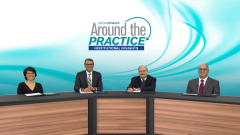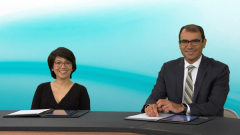
Recent Updates on Treatment Options for Patients With Transplant-Eligible NDMM
Comprehensive insight on induction therapy regimens in transplant-eligible newly diagnosed multiple myeloma based on the GRIFFIN, MASTER, and DETERMINATION clinical studies.
Episodes in this series

Transcript:
Alfred Garfall, MD:This was a relatively young patient, and so we were thinking from the beginning that the patient would be a candidate for autologous stem cell transplantation. In that context, Ed, would you comment a little on the GRIFFIN study, which studied this daratumumab–VRd [bortezomib, lenalidomide, dexamethasone] combination in transplant-eligible patients?
Edward Stadtmauer, MD: Thank you. As Dan [Vogl] was saying, daratumumab in combination with cyclophosphamide and bortezomib is a great way of rapidly getting patients into remission. Besides that, we’re learning that starting with daratumumab is a very reasonable initial therapy. The GRIFFIN study has opened our eyes to the addition of a CD38-directed therapy as part of the initial therapy. In this study, patients with standard-risk multiple myeloma were either randomly assigned, in a phase 2 fashion, daratumumab–VRd [bortezomib, lenalidomide, dexamethasone] vs VRd [bortezomib, lenalidomide, dexamethasone]. Patients who received the quadruple regimen have amazingly high response rates, deep responses, and durable responses relative to the VRd [bortezomib, lenalidomide, dexamethasone] regimen. In this study, the patients went on to stem cell transplant, high-dose melphalan, and autologous stem cell transplantation. With recent follow-up from IMS [International Myeloma Society Annual Meeting and Exposition], these data continue to support the activity of this quadruplet regimen.
Alfred Garfall, MD:Anytime we incorporate a new drug before stem cell transplant, we have questions about how it will affect transplant itself. We worry about stem cell collection, and we worry about engraftment after stem cell transplant in someone who was exposed to a new agent that hadn’t been previously tested prior to transplant. Does anyone want to comment on the safety of daratumumab when used pretransplant in terms of guaranteeing that patients will be able to collect sufficient stem cells and go on to have a safe and effective stem cell transplant?
Sandra Susanibar-Adaniya, MD: The data that came out of the GRIFFIN study are very important. As you mentioned, Al, we want to know that this is safe for patients, that it won’t preclude their ability to collect the stem cells. The data have shown that patients can safely receive this novel induction, go for a stem cell collection, collect adequately, and go for transplant, without an increased number of complications, and then they can go for maintenance. That’s very important.
In addition to the GRIFFIN trial, we also have data from the MASTER trial, which used a different quadruplet regimen. Instead of using bortezomib, they use carfilzomib. Also, the preliminary data from that study, which has a short follow-up, haven’t risen any red flags about collection. For people like these patients, who needed a rapid and very deep response, based on his high-risk cytogenetics with deletion 17p, a daratumumab-based regimen will be an excellent choice.
Edward Stadtmauer, MD: The vast majority of patients who receive the daratumumab-containing regimens initially are able to achieve the number of stem cells collected. That’s the goal. Perhaps it’s slightly less than the non-daratumumab-containing regimens. Engraftment after stem cell transplant for those patients appears to mimic the patients on non-daratumumab-containing initial therapy.
Alfred Garfall, MD:One of the most important factors for an adequate stem cell collection is good disease control. We always talk about the potential mechanistic effects of new drugs on stem cell collection, and those are important to consider. Occasionally, if somebody is having a partial response to first-line therapy, I’ve found that 1 concern they have about taking that patient to stem cell transplants is that there will be too much disease burden to collect stem cells. Often, I’m intensifying the first-line therapy in patients who’ve had a tepid response, especially if there’s a low marrow involvement by the myeloma. That better response can, at least in theory, improve the likelihood of a successful stem cell collection.
Let’s talk a little about transplants. We got new data in the last year from a long-running study, the DETERMINATION study, which randomized patients who are transplant eligible and had received induction therapy based on bortezomib, lenalidomide, and dexamethasone to undergo a transplant or collect stem cells for potential use of transplant in a later line of therapy. That was the DETERMINATION study. Sandra, can you talk a little about that study, its design, and what we learned in the last year about the outcomes?
Sandra Susanibar-Adaniya, MD: This study has provided very important data. It enrolled patients with newly diagnosed multiple myeloma, regardless of their risk stratification at diagnosis. Patients were enrolled, screened, and treated with triple-induction regimen: Velcade, Revlimid, and dexamethasone. Patients received 4 cycles of induction, and all of them collected stem cells. They were randomized in a 1:1 ratio for transplant up front vs delay transplant at first relapse. The patients, after the transplant, started the standard of care with maintenance and lenalidomide. What we have after a little more than 6 years of follow-up is that better disease control was shown in the people who received transplant up front, validating what was seen in the previous IFM study [in 2009]. If people who had collected stem cells relapsed, almost half needed to receive the transplant. At that time, transplant was able to provide disease control. At that stage of follow-up, no differences in overall survival were seen, but we don’t know if we have a different readout with prolonged follow-up.
Transcript edited for clarity.
Newsletter
Stay up to date on recent advances in the multidisciplinary approach to cancer.




















































































